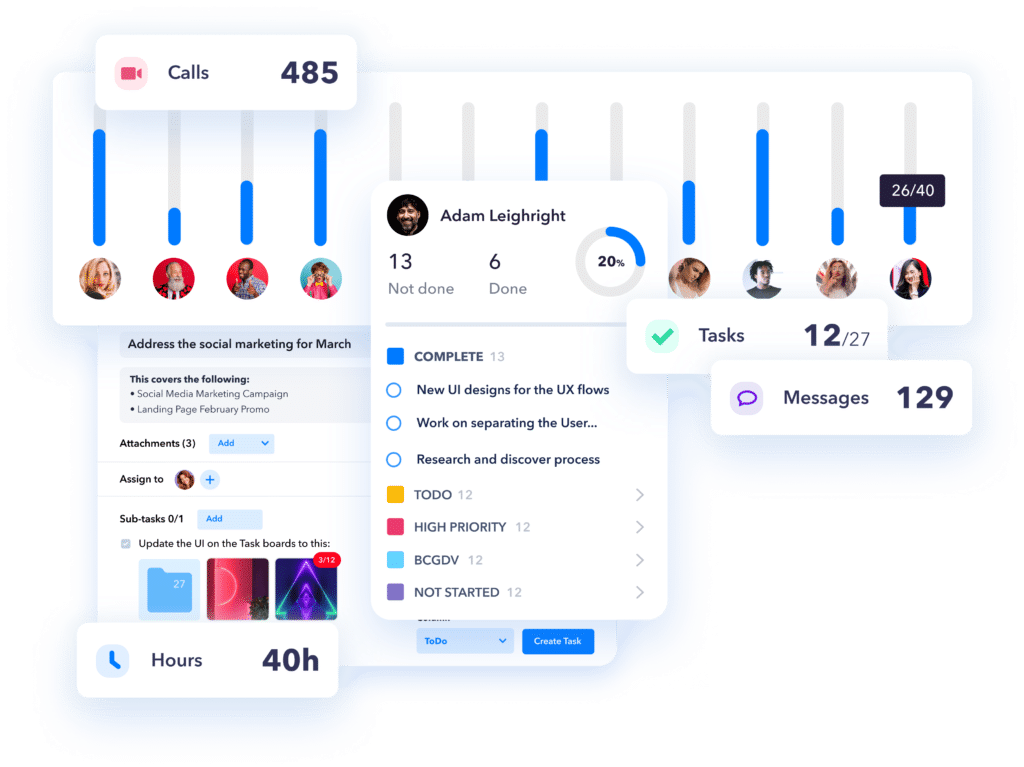The hallmark of a successful leader is the ease with which they can inspire their team to work toward a common goal. That is to say, successful leaders have efficient teams. As the number of teams increases along with a dramatic change in work models, how to improve team efficiency has become a primary concern for most organizations.
When you improve team efficiency, you’re creating an environment where people can function at their best. This helps you aim for more challenging goals and improve your performance, be more innovative, increase your cash flow, and bring in more profits.
What is team efficiency?
Before we learn how to improve team efficiency, let’s understand the idea. Team efficiency might sound similar to team productivity but it’s important to understand that there’s a difference between the two.
Team productivity is about the ratio of outputs that a team can generate in relation to the inputs it receives. This could vary for different projects and domains. Team efficiency is how you use the lowest possible amount of inputs to generate an exceptional amount of outputs.
Another way to look at it is that team productivity is about a metric while team efficiency is about a process.
Team efficiency vs team productivity
But why should we distinguish between the two? Because it helps us improve team efficiency even if productivity levels are satisfactory. So, even if you believe that your teams are productive, you might find that there’s room for improvement.
Your productivity metrics could be based on your historical performances. These may not give you an objective analysis of the opportunities and weaknesses in the system. When you begin to improve team efficiency, you will unearth these.
The other reason to focus on team efficiency is that you will be making systemic changes to improve your processes. Unlike with productivity, you’re not dealing with a single metric for a one-off project or task. You’re looking at fundamental ways to improve operational efficiencies in the system.

12 ways to improve team efficiency
You don’t have to indiscriminately hire for projects or ask for more resources. These are some of the most effective ways in which you can improve team efficiency and make your systems more productive.
1. Have attainable goals
Every project has a goal but to improve team efficiency, what you need are objectives that you can attain with the resources you currently have or can incrementally add. What you don’t want are confusing goals that don’t take into account your talent or resource bandwidth.
No matter how big or complex a project is, you can always divide its goal into smaller, attainable, and manageable units. This boosts the confidence of team members because they will believe that they have a bigger chance of achieving these goals.
2. Clarify everyone’s roles
To improve team efficiency, each member of the team needs to know what’s expected of them and others. This will remove confusion and delays. Along with each other’s roles and responsibilities, people should also know the skillsets the others bring to the table.
With greater clarity on individual roles, there will be less overlapping and redundancy. This increases productivity and gets rid of confusion. It also helps managers understand which individual would need training in which specific domain.
3. Give individuals ownership
Autonomy is the key to not just increased productivity but also job satisfaction and engagement. This is something that all great leaders know. When you give your team members ownership of their tasks and empower them to make decisions, you’re showing them that you trust them.
Ownership increases accountability and encourages people to see themselves differently. It demonstrates that your organization isn’t hierarchically rigid but is one that respects its employees.
4. Identify individual strengths and weaknesses
Successful managers know that different individuals have different kinds of both technical expertise and soft skills. When there is a misalignment between an individual’s ability and responsibility, you can expect subpar output and delays. Understanding who can perform a job better will help you improve team efficiency.
Those who are adept at creative ideas should be given tasks that require innovative thinking. Those who excel in execution should be given responsibilities that need attention to detail. Those who communicate well should be the ones who reach out to external stakeholders.
5. Ensure effective communication
The single biggest factor that can improve team efficiency is proper communication. Without an effective communication protocol, there will be misunderstandings and project delays. That’s why organizations should reevaluate their internal systems and roll out strategies for better team communication habits.
With seamless communication, team members will know the precise project requirements, what they have to do, and what tasks others are performing. A specialized project management tool such as Heycollab provides multiple channels of communication while empowering employees to access key resources. This aligns everyone on the team and improves the quality of the output.
6. Don’t micromanage
Constantly looking over the shoulders of your employees not just interrupts their flow but also tells them that you don’t trust them. Micromanagement is the opposite of empowerment and it’s one of the more common reasons why employees feel disengaged from work.
Once you delegate a task with clear expectations, get out of the way of your employees. But remain approachable in case they were to have some concerns. What you mustn’t do is regularly disturb them with suggestions or queries. “I trust you” is one of the most magical words a leader can say to their team members.
7. Reward your team
Every employee needs a reason to perform well. Instead of a mere message of appreciation in the company newsletter, employees would prefer something more tangible such as a monetary reward. This is why many organizations have incentive programs to motivate their employees.
Incentives need not be in the form of cash. They could be paid vacation, free vouchers, lunch-outs, extra time off, etc. These will encourage others to do their best and create healthy competition within the system.

8. Develop efficient workflows
Organizations with high team efficiency have optimal workflows. This ensures that work seamlessly gets done without the need for distracting meetings and communication. When employees know their specific responsibilities and how to get the necessary resources, they will accomplish more things faster.
With a digital tool such as Heycollab, you can organize your team structure, provide greater transparency, give adequate information, and empower individuals to collaborate with each other. This is how you boost productivity and reduce the wastage of resources.
9. Practice gratitude
Rewards, whether monetary or otherwise, are good. But what’s equally important is to demonstrate gratitude as a leader. Thanking your team members for their work can go a long way in inspiring them to perform at their best. Importantly, it also immensely improves the office environment.
Gratitude creates a sense of camaraderie and makes everyone feel involved. It humanizes the manager and allows employees to be truthful. It also creates a culture where people appreciate each other’s efforts and collaborate better for team goals.
10. Provide coaching and training
The technology landscape is changing quickly and even highly talented employees would need organizational support to keep up with the pace. It also makes companies more innovative and up-to-date with key trends. Organizations that have effective training programs will also find it easy to attract and retain top performers.
For training to be effective, it has to be customized. Analyze the skill sets that your employees would need and then organize coaching programs that suit their schedules. Leaders can also encourage team members to train each other in domains they’re proficient in.
11. Provide constructive feedback
Unfortunately, feedback tends to be mostly negative in organizations. This only ends up highlighting the employee’s weaknesses and when done indiscriminately, can demotivate them. What’s needed is constructive feedback whereby managers are working with the employees to improve their performance.
At times, all it might take is a minor tweak for a team member to be more effective. With constructive feedback, a manager can become a coach to their employees and become invested in their success. This creates a culture of trust and respect.
 –
–
12. See employees as individuals
Employees are not merely names on a dashboard or email thread. They shouldn’t be bundled under one homogenous group with the same concerns and ambitions. To improve team efficiency, it’s vital that you see them as human beings with their own hopes, fears, and challenges.
Have more casual conversations and get-togethers with your team members. Ask them individually about what’s happening in their lives. Have one-on-one meetings if you sense a person is having problems.
An advanced digital tool can significantly help you improve team efficiency. Heycollab is a project management tool built for teams like yours. With a free 14-day trial, you can try out all the cool features. To get started, visit https://heycollab.com/

